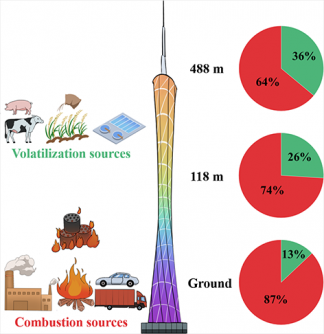Top Stories
Researchers Confirm Combustion Dominates Ammonia Levels in China

URGENT UPDATE: New research from Jinan University reveals that combustion-related activities are the primary contributors to atmospheric ammonia in the Pearl River Delta (PRD), China. This critical study, published in Frontiers of Environmental Science & Engineering, highlights the urgent need to address air quality issues in this densely populated region.
According to the findings released just today, ammonia (NH3) is a key precursor to harmful fine particulate matter (PM 2.5), which poses significant health risks. The study identifies specific sources of ammonia emissions at different atmospheric heights, an area that has been poorly understood until now.
Researchers collected samples from three heights—ground level, 118 meters, and 488 meters—utilizing atmospheric observatories at Canton Tower, the tallest structure in the PRD. The results show average ammonium ion (NH4+) concentrations of 2.7 ± 1.4 μg/m³ at ground level, 3.0 ± 1.8 μg/m³ at 118 m, and 2.6 ± 1.7 μg/m³ at 488 m. Notably, there were no significant differences in concentrations among these heights, indicating a pervasive issue across the board.
However, a crucial finding is the significant correlation between stable nitrogen isotope composition values in NH4+ and height, suggesting that emissions vary with altitude. The researchers employed the Bayesian Isotope Mixture Model for more precise source apportionment, revealing the following contributions at ground level: agriculture (9.9% ± 4.4%), waste (8.3% ± 5.5%), vehicles (29% ± 8.0%), biomass burning (16% ± 2.2%), NH3 slip (25% ± 6.0%), and coal combustion (12% ± 3.4%).
At the higher 488 m level, emissions remained comparatively stable, highlighting the lesser impact of local activities on ammonia levels. This stability underscores the ongoing challenge of addressing air quality in urban environments where combustion sources dominate.
The implications of this study are profound, with air quality directly affecting the health of millions living in the PRD region. With pollution levels already a public concern, these findings stress the need for immediate action to mitigate emissions from combustion sources.
Next Steps: Authorities and environmental groups are urged to consider these findings in policy-making and public health strategies. The research indicates that understanding and addressing combustion emissions could lead to significant improvements in air quality.
For those interested in the full study, more details can be found at the following link: Frontiers of Environmental Science & Engineering.
This urgent news serves as a wake-up call for the Pearl River Delta region—a critical area needing immediate attention to combat air pollution and protect public health.
-

 Business5 days ago
Business5 days agoUK to Finalize Stablecoin Regulations by 2026, Boosting Crypto Sector
-

 Business6 days ago
Business6 days agoU.S. and U.K. Target Cybercriminal Networks, Seize $15 Billion
-

 World5 days ago
World5 days agoMilitary Artillery Plan Sparks Safety Concerns Along California Highway
-

 Lifestyle6 days ago
Lifestyle6 days agoKISS OF LIFE’s Natty Dazzles in Micro-Shorts at Seoul Event
-

 Sports6 days ago
Sports6 days agoDomenico Doran’s Stellar Performance Leads Bishop Amat to Victory
-

 Business6 days ago
Business6 days agoCalifornia to Eliminate All Plastic Bags from Stores by 2026
-

 World6 days ago
World6 days agoTrump Signals Reluctance to Sell Tomahawk Missiles to Ukraine
-

 Entertainment6 days ago
Entertainment6 days agoLouisiana Senate Raises Concerns Over Medicaid Cuts Amid New Bill
-

 Entertainment6 days ago
Entertainment6 days agoUtah Communities Rally as Government Shutdown Strains Resources
-

 Health3 days ago
Health3 days agoUncovering the Hidden Link Between Knee Pain and Hip Issues
-

 Sports6 days ago
Sports6 days agoTrade Low, Trade High: Key NHL Players to Consider Now
-

 Science3 days ago
Science3 days agoAncient Dinosaur Discovery in Argentina Reveals Evolutionary Insights









